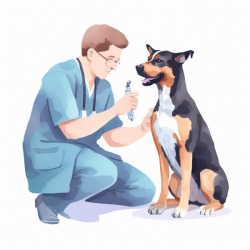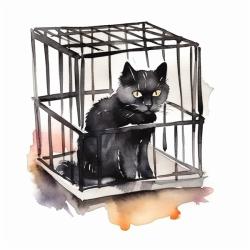The Whiskers, Paws, and Love team believes that surgery should be done on pets only for health reasons. In our opinion, all cosmetic surgeries and procedures are unethical - with one arguable exception* - because they are driven either by appearance or by competition (conforming to a breed standard). Neither of which improves your pet’s quality of life.
Tail docking of dogs
Tail docking of dogs is thought to have originated during the Roman Empire, when people believed that rabies could be prevented by removing the tip of a dog’s tail. After that was discredited, tails were docked to prevent work-related tail injuries (the so-called ‘work’ was bear baiting, bull baiting and fighting) which no longer exist, or should no longer exist. Today, tail docking is almost entirely done to conform to a distinctive breed appearance or standard, or simply because owners like the way it looks. Due to the influence of kennel clubs “Breed Standards” put pressure on breeders and show exhibitors to dock their dog’s tails. Tail docking is the AKC standard for more than 60 breeds, which translates to nearly a third of the breeds on the registry.
Tail docking is mutilation that deprives a dog of an integral part of his anatomy. The procedure is usually carried out surgically using scissors to cut through the skin, muscles, tendons, ligaments, nerves and bone while the puppy is fully conscious and aware. Some experts argue that neonatal puppies do not have a fully developed nervous system and can't feel the pain of tail docking, but there is plenty of evidence to the contrary. Puppies yelp and cry out when they have their tails docked, making some experts believe they are even more sensitive to pain than older dogs. Following the procedure there is, obviously, a risk of infection and complications with wound healing, as well as with tumors, leaking of the cerebrospinal fluid, and even death.
Tail docking puts dogs at a disadvantage in several ways. Particularly significant is the fact that dogs use their tails to express themselves and to communicate with other dogs, and with people. An assertive dog will hold his tail high; a happy dog will wag his tail; a frightened submissive dog will tuck his tail between his legs. They can’t effectively convey this information using only a stump. A dog without a tail is literally handicapped in conveying fear, caution, aggression, playfulness, etc. Tail length is important in the transmission of social cues. Longer tails are more effective than shorter tails at conveying different cues, such as those provided by tail motion. Dogs with shorter tails are usually approached with caution because the approaching dog is unsure of the emotional state of the docked dog. Due to this inability to communicate properly, some dogs with docked tails may become aggressive because they cannot signal their intent and are misunderstood by other canines. Dogs need their tails for balance, and some use them as a rudder when swimming. Videos comparing docked and undocked dogs running and jumping show that dogs who are docked must work harder to compensate for the loss of the tail, andthere is extra stress imposed on the joints that can have long-term health consequences.
It is an outrage that tail docking is still legal in the US and that it is encouraged by the AKC for specific breeds. We don’t recommend buying a puppy, but if you do, please avoid purchasing one with a docked tail. Have a heart and let dogs keep their beautiful long tails.
Tail docking of horses
Tail docking of horses is an amputation of the spinal column. It was originally done for practical purposes (to keep their hair from getting tangled in wagon hitches and to keep the horse's rear clean so they would be easier to harness). In our modern society, the practice is considered an unnecessary cosmetic procedure. In addition to the pain of the docking surgery itself, the loss of the tail also causes life-long misery for the horse because their tails serve many purposes: as an indicator of emotional state; assisting in temperature regulation; a protective barrier for the anus and vulva; an appendage that aids in balancing, and as an insect deterrent. Horse’s tails are used to control flies, mosquitoes, horseflies, wasps, or any other flying insect that may bother them. In just one day, a horse can lose a cup of blood to biting insects such as mosquitoes. Not only do the mosquitoes take blood, but they also give disease. If you have two horses who are friendly with one another, you may see them taking turns standing in front of one another and swishing their tails to deter flies from landing on their friend’s face. Finally, since horses are herd animals, the ability to communicate with one another is vital to the security and harmony of the herd.
Ear cropping
Like tail docking, ear cropping is an ancient procedure which was initially done to prevent bite injuries from predators or other dogs. Health benefits attributed to ear cropping included improved hearing and a decrease in ear infections. There is no scientific rationale for those claims. Today, ear cropping is done purely for cosmetic reasons. It is a choice by the owner, or it is done to meet the standard in approximately 20 dog breeds, including Dobermans, Great Danes, Boxers, Schnauzers, and many others. It involves the surgical removal of part or all of the external visible flap of the ear and is usually done when they are puppies. The ears will be taped and re-taped and the bandages changed frequently over a period of at least six weeks, causing their ears to be sensitive for many weeks post-surgery. Successful ear cropping is not guaranteed. There is a chance the puppy will need more operations. IF there are no complications, it will take 4-5 months before the ears are fully healed. Complications can include the following: misshaped ears; wound infections; excessive bleeding; loss of hearing; swelling at the injection site; a negative psychological effect due to the traumatic experience; phantom pain (if you had an appendage removed you might have experienced it), and there is the possibility your dog will need to undergo amputation. More severe risks also include anaphylactic shock (difficulty breathing, low blood pressure) or death. Other repercussions from having a dogs ears cropped are that many people are likely to treat dogs with cropped ears in a negative way due to the dog’s fierce appearance; and dogs won’t be able to pull back their ears as a warning when they are feeling aggressive, putting people at risk of being attacked.
Neutering
Neutering is a common surgical procedure performed on male dogs which is essential for population control, behavior modification, and disease prevention. Although a neutered male dog is the norm, some dog owners dislike the appearance after neutering. Many men don’t want to neuter their pets because they don’t want to put the pet (or themselves) through that experience! Seriously! In 1995 a man got rich by inventing Silicon Testicular Prostheses (aka Neuticals) which can be implanted at the time of neutering, or later, to recreate the pet’s normal male anatomy. Canines, felines, equines, bulls or any pet which is neutered can be implanted with Neuticles. It is implausible that castrated animals miss what they lost since they don’t view sex and sexuality in the same way as people do. Who can explain why pet owners pay hundreds of dollars, and risk the possible complications of surgery to have Neuticals implanted in their pets solely to please themselves? And what if a dog had Neuticlesimplanted, and he ran away and found new owners? He might end up getting neutered twice!
Braiding
Besides surgery there are other, seemingly less risky, things that owners might subject their pets to for appearance purposes. Many people who take their horses to shows braid the horse’s manes and tails. When done right, it is a remarkable sight. However, when you braid a horse’s tail, you are potentially putting her at risk. The dock of the tail (also referred to as the root of the tail) is extremely sensitive to pressure. Braids that are too tight or too close to the tail bone can cut off circulation. The result of poor blood circulation includes health risks such as a decrease in body temperature, less ability to fight infection, and the entire tail can die! Braided tails are more painful for the horse because of the extra bulk and weight. Tails braided to the end decrease the ability to naturally deter biting insects - the horse’s natural tail is far more effective at hitting targets. Most horses do not like having their manes braided because it can restrict the movement of their heads. It’s important to ensure that the horse doesn’t have any discomfort putting his/her nose to the ground. Braiding too tightly, using rubber bands, and leaving braids in for too long damages the mane or tail. Depending on the horse’s genetics, it can take up to seven years for the hair to regrow. Braids should be removed the moment a horse is back in the trailer or barn to make them more comfortable and to prevent injuries. Never turn a horse out to pasture with a braided mane or tail and never leave them braided overnight in the stall. Tails can become lodged in pretty much any opening (fences, gates, pipe panels, horse trailer dividers or low tree branches). If her tail gets stuck, she may panic and yank so hard that she rips her tail at the dock. This can cause severe nerve damage, spinal problems, and even brain damage to the point where you’ll have no choice but to do the unthinkable. If a braided mane gets caught on something, it will likely rip out a section of hair as well as rip the skin.
Dyeing
Some people dye their pet’s hair for festivals, holidays, because they’re bored, etc. We believe there are legitimate reasons to put chemicals on your pet (to prevent fleas and ticks, for instance) but it’s reckless to use them for cosmetic reasons. And you should not, under any circumstances, use human dye products on a pet. They contain toxic chemicals which could cause illnesses/injuries to your pet such as: irreparable damage to a dog's immune system, allergic reactions, chemical burns, skin diseases, blindness, and cancer. Because an animal’s first instinct is to lick, dye can also cause poisoning or internal burns. Frankly, hair dye isn’t safe for humans either! If you want to make your pet look more attractive, how about buying him a fancy collar or a bandana?
Intraocular Prosthesis.
Veterinarians can surgically implant eye replacements for dogs to retain a more normal appearance than if the lid is sutured shut after removal of the eye. The surgery is purely for the owner’s benefit since some owners are bothered by a missing eye. While the placement of the prosthesis is a cosmetic procedure, it differs from tail docking and ear cropping in that the procedure is performed in response to a medically necessary procedure and it restores a somewhat normal appearance to the dog’s face. The procedure is only done on dogs. It is not suitable for cats because the rate of complications is high in cats.
“...The animal shall not be measured by man. In a world older and more complete than ours they move finished and complete, gifted with extensions of the senses we have lost or never attained, living by voices we shall never hear. They are not brethren, they are not underlings; they are other nations, caught with ourselves in the net of life and time, fellow prisoners of the splendour and travail of the earth.”
- Henry Beston, The Outermost House: A Year of Life on the Great Beach of Cape Cod




